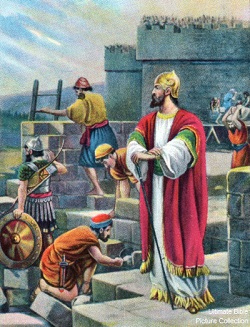

|
| Musical Musings: Liturgy |
The First "Eucharistic Procession"and the Centrality of the LiturgyThis article is reprinted from the 2 June 2024 issue of The Dispatch at Catholic World Report, with the kind permission of the author.
The Venerable Bede and Matthew Levering — commentators "both old and new" (cf. Matt 13:52) — each explore different ways in which the return of the Remnant community foreshadows the universal Church, but one must go to the rabbis to find one particularly timely "transparent prefiguration": Namely, the first-ever "eucharistic procession." Nehemiah 12:27–43 recounts the "dedication" of the walls of Jerusalem as a culminating moment in the restoration of Jerusalem following the Babylonian Exile. Solomon's temple had previously been "dedicated" (cf. 1 Kgs 8:64) — a liturgical term of art that implies consecration to the Lord's unique service — but, at least according to the books of Kings and Chronicles, the city walls were not. Nehemiah's action accordingly appears unprecedented in Israel's history. The ancient rabbis, as well as contemporary scholar Tamara Cohn Eskenazi, recognize that this "dedication" extended some of the Second Temple's holiness to the entire city of Jerusalem, and represented Nehemiah's solemn consecration of Jerusalem as a "temple state" — one in which citizenship in the province of Judah corresponded largely to one's standing in the temple community. But one feature of this "dedication" stands out to us as we come to the final stages of our national Eucharistic revival. The Scripture tells us that Nehemiah celebrated "the dedication … with thanksgivings" (Neh 12:27). Nehemiah himself recounts that "I appointed two large thanksgivings," each to head a procession that went in opposite directions around the wall, meeting in the middle (12:31, author's translation). One "thanksgiving" went to the right, and the other to the left (12:13, 38). Now, the RSVCE translation renders the Hebrew word "thanksgiving" as "company which gave thanks" (Neh 12:31, 38; cf. NAB), but the rabbis did not read the passage this way. The Hebrew (Masoretic) text just says "thanksgivings"; thus, rather than interpreting the "thanksgivings" as companies of persons giving thanks, the rabbis understood the "thanksgivings" in light of the ancient todah offering. A todah offering — in English, a "thanksgiving" offering; in Greek, a eucharistia — was made by ancient Israelites after being delivered from deadly peril. The todah offering took different forms, but it customarily involved bread and wine (cf. Gen 14:17–20). Accordingly, reading the account of Nehemiah's "dedication" of the wall, the ancient rabbis did not think Nehemiah appointed companies of thanksgiving singers. Rather, they understood Nehemiah to have commanded the priests to carry large "thanksgiving" breads at the head of the twin processions. If this interpretation is correct, the "dedication" of the city wall of Jerusalem — which extended somewhat of the temple's holiness to the entire city — was accomplished by way of a "eucharistic" procession. The significance of this interpretation for our current day is plain enough. Putting the "source and summit" of our faith, first and foremost — at the head of our efforts at renewal — promises a renewal of holiness among God's people. Arguably, the extension of the temple's holiness by way of the city wall's "dedication" itself forms "one of the most transparent prefigurations of the Church." For the Church shares in the holiness of Jesus Himself, the new Temple (cf. Jn 2:21), as members of His Body (cf. Rom 12:1–5). Christ's redeeming sacrifice — in commemoration of which we offer the Eucharist, the Christian todah (cf. 1 Cor 11:26–28) — affected what Nehemiah's dedication prefigured: The sharing of one common holiness among all God's people. But it may also be significant that Nehemiah's dedication took place by way of the bread of the todah offering. In the Christian dispensation, as Sacrosanctum concilium reminds us: "The liturgy is the summit toward which the activity of the Church is directed; [but] at the same time it is the font from which all her power flows" (§ 10). The liturgy, according to the Council Fathers, "is the primary and indispensable source from which the faithful are to derive the true Christian spirit" (§ 14). The Eucharist is the ultimate source of our continuing and deepening consecration to the Lord. Nehemiah appears to have grasped the same truth. Putting the todah breads foremost among the "dedication" processions was how he affected an unprecedented consecration of Jerusalem to the service of the Lord. The lesson for us is obvious: "Go and do likewise" (cf. Lk 10:37).
Article written 2 June 2024 |
Submit Your Music / Contact Us / Company Description / Links
 The Book of Ezra-Nehemiah is one of the most relevant biblical texts for today because it portrays the agonizing efforts of Church renewal.
In this light, it's far too little known that the Catechism of the Catholic Church states unequivocally that "the Remnant of the poor that returns from the [Babylonian] Exile is one of the most transparent prefigurations of the Church" (§ 710, emphasis added).
The Book of Ezra-Nehemiah is one of the most relevant biblical texts for today because it portrays the agonizing efforts of Church renewal.
In this light, it's far too little known that the Catechism of the Catholic Church states unequivocally that "the Remnant of the poor that returns from the [Babylonian] Exile is one of the most transparent prefigurations of the Church" (§ 710, emphasis added).